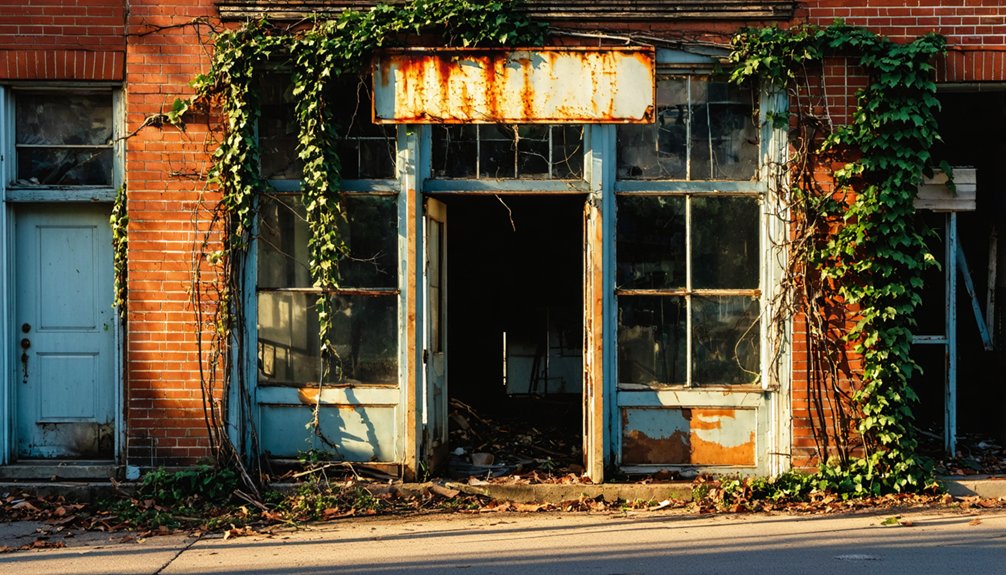Alabama became the 22nd state on December 14, 1819. The fifth president, James Monroe, signed an act on March 2, 1819, that paved the way for Alabama to enter statehood later that year.
There are 66 ghost towns in Alabama.
Alabama is a state full of history that helped create our country. Largely known for the state’s involvement in the Civil Rights Movement, voting rights, the U.S. Space Center, and many museums showcasing the lives and events of previous times, a visit through Alabama is a must. The ghost towns of Alabama are simply the icing on the cake.
Fort Gaines, Alabama
Fort Gaines, Alabama, is a composition of military buildings located on Dauphin Island, established in 1821. Being developed as a defense fortress to protect the territory during the Battle of Mobile Bay and throughout the Civil War, the fort survived many battles. The fort is in an excellent strategic location to monitor and control most of the Gulf of Mexico, block the Mobile Bay entrance, and prevent foreign troops from moving inland from the sea.
The tunnel systems within Fort Gaines were used quickly to transport supplies and move from one posted location to another while under enemy fire. Hurricanes and tropical storms severely damaged the outer walls of the fort, exposing the inhabitants to new dangers.
Since opening to the public, the fort has been a popular tourist destination. Fort Gaines is also a well-known spot for paranormal investigators, groups, and clubs trying to communicate with the past’s spirits. Visitors have reported paranormal experiences including phantom footsteps, unexplainable dark shadows, and figures that resemble soldiers.
When planning a trip to Fort Gaines, it is essential to remember that the fort is old and has suffered from both battle and weather damage. To maintain visitors’ safety, some site areas will be off-limits without permission for approval.
Old Saint Stephens, Alabama
St. Stephens, Alabama, has a fascinating history that involves not one but two towns: Old St. Stephens and New St. Stephens. The site of Old St. Stephens, located on the Tombigbee River, is no longer inhabited. Still, during its peak, it served as the territorial capital of the Alabama Territory from 1817 to 1819. When Huntsville took over the title of territorial capital in 1819, Old St. Stephens started to get bypassed as New St. Stephens was being built two miles inland.
Starting in 1782, before there was an old or new St. Stephens, a British surveyor noted the area would be suitable for a settlement. In 1789, the territory was under Spanish control again, and a fort was established. By 1796, over 250 settlers from the United States resided around the fort. Three years later, in 1799, following the Revolutionary War and the Treaty of San Lorenzo, Spain transferred ownership of the land and fort back to the United States.
A trading house was built in 1803 and named after the Choctaw Native American tribe known to the area. One year later, a judge from the Mississippi territory wrote a letter to former president Thomas Jefferson describing St. Stephens’ residents as savage, illiterate, unworthy, and distrustful, among other things. Lorenzo Dow, a minister, saw the town’s description as a challenge, and when asked to leave town, he prophesied the town’s demise.
In 1805, George Gaines was appointed as the federal representative to the people in the area, and after residents requested official recognition, Saint Stephens was officially a town on January 8, 1807. Forty homes were reported in the town by 1816. After being named the territorial capital in 1817, St Stephens witnessed significant growth with over 500 homes and a mix of over 20 stores, a school, hotels, offices, and even a theatre by 1819.
When the decision was made to change the capital from Saint Stephens to Cahaba in 1819, its success began a dangerous downward slope. The town’s popularity was decreasing without its status, shallow boats that could pass over the shoals made traveling upriver easier, and a yellow fever outbreak resulted in many fatalities. A railway constructed to bypass the town was the final blow that ended Old St. Stephens and made way for New St. Stephens two miles inland.
The once-thriving town was reduced to a village with only a few residents remaining in 1833. As the Civil War approached, New St. Stephens took over as St. Stephens, and the old town was no more. Old St. Stephens was listed on the National Register of Historic Places on December 29, 1970. In 1988, the Old St. Stephens Historical Park was created.
Battelle and Bluffton, Alabama
Battelle and Bluffton were iron ore mining towns located north and south of each other on the present-day Alabama-Georgia state line. Battelle, Alabama, was home to hundreds of residents as the city was known to have hundreds of houses, a school, hotels, a post office, and general stores. The Lookout Mountain Iron Company set up operations to extract the substances and create pig iron when good-grade iron ore, coal, and limestone pockets were located.
Colonel John Gordon Battelle led The Lookout Mountain Iron Company and named the operation after himself after taking a considerable personal interest in the mining project. After living in and mining the area for some time, Battelle determined the mineral deposits’ quality not to be of good enough quality and quantity to compete with Birmingham mines. Mining operations were put on standby in 1905 while houses and other buildings were sold, moved, or demolished.
The British government bought the Battelle furnace during World War I and shipped it to Calcutta, India. The Belcher Lumber Company started a lumber operation in Battelle during the 1940s, but it did not stay longer than a few years. Battelle made news again in 1969 when a train carrying propane tanks derailed, and an explosion was reported.
Bluffton, Alabama, was home to nearly 8,000 residents after being founded in 1890 as an iron ore mining town. The Bluffton Land, Ore, and Furnace Company oversaw mining operations and built the famous Signal Hotel. The Signal Hotel was the first building in Cherokee County to host electrical lights.
The town also had two churches, a Methodist Episcopal and the Salem Baptist Church, a school, a local newspaper, a post office, a waterworks system, and the county’s first electrical generating plant. The University of the Southland was a college planned to be built in town, but it was never done even after the initial groundbreaking in April 1889.
The town was set up for success and saw many great days, months, and years. Like the town of Battelle, business began to falter when higher-grade iron ore was mined out of Birmingham. Bluffton fell into ghost town status in the early 1900s.
Washington, Alabama
Washington, Alabama was first established in 1817 in Autauga County. The town was developed on Atagi, a former Autauga Indian town named after George Washington. From the year 1819 until 1830, Washington was assigned the role of Autauga County seat. The town once boasted a courthouse, jail, post office, hotel, and even a pillory. In 1830, residents began to leave when the county seat was moved to Kingston, Washington. The town was unfortunately abandoned by 1879.
Ghost Towns Worth A Visit
Arcola, Alabama, was founded in the early 1820s and named to honor the French victory at the Battle of Arcola. The founders of Arcola were French Bonapartists, who followed Napoleon Bonaparte and hoped to restore the government to the House of Bonaparte. Also known as the Vine and Olive Colony, the founding residents feared for their lives after Napoleon Bonaparte’s fall. They tried to start an agricultural settlement growing wine grapes and olive trees in western Alabama.
Arcola’s size never grew more than that of a village, but it was the largest settlement in the colony. In the 1830s, American settlers started moving into the area and began purchasing former French land grants. By the 1850s, the French settlement had vanished and was replaced by a community of American plantations.
Bellfonte, Alabama, is a ghost town in Jackson County. Today it can be found near the Bellfonte Nuclear Generating Station. From 1821 to 1859, the town served as the county seat for Jackson County. Suffering from damage due to the Civil War, the town had a hard time recovering over the next few decades and eventually was empty and deserted by 1920. A cemetery, piles of bricks, and an old chimney from the Inn are all that remain.
Vienna, Alabama, was situated along the eastern shore of the Tombigbee River. The town, established in the 1830s, saw much success as a river port until the Civil War from April 1861 to May 1865. The war affected the town’s success, but the town was on a rapid path to an end when a post-war railroad was built through the county. When the post office ceased operations in 1917, the town officials had an ending.



